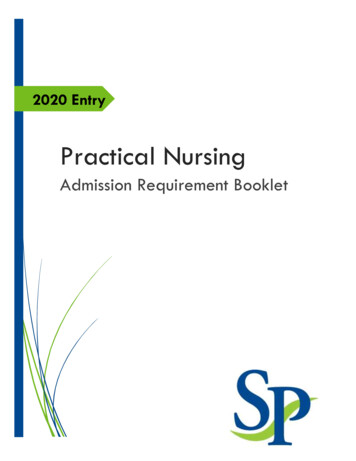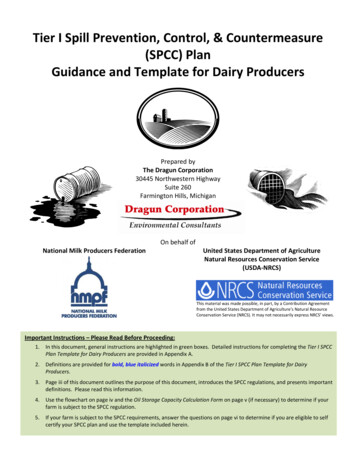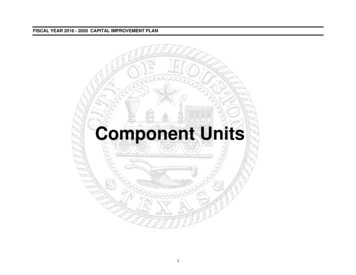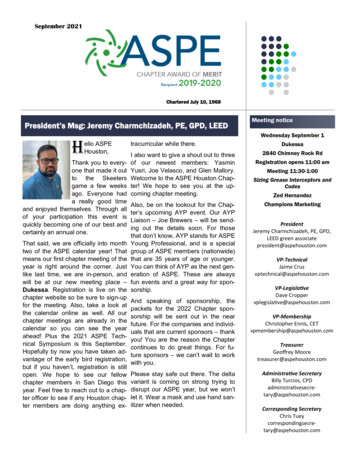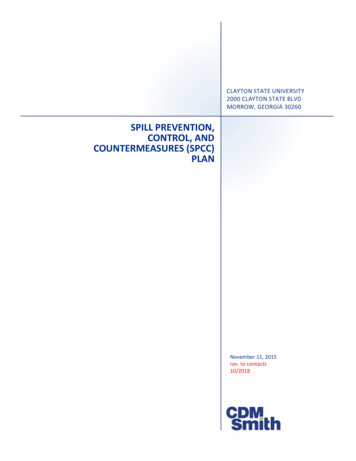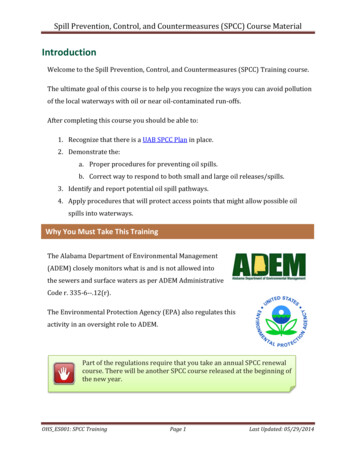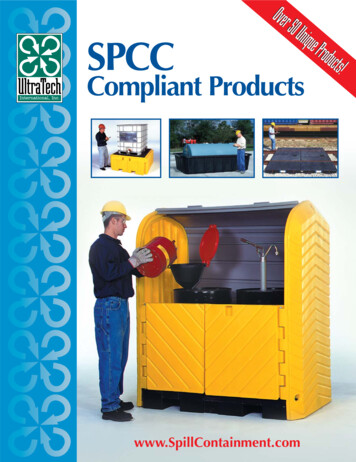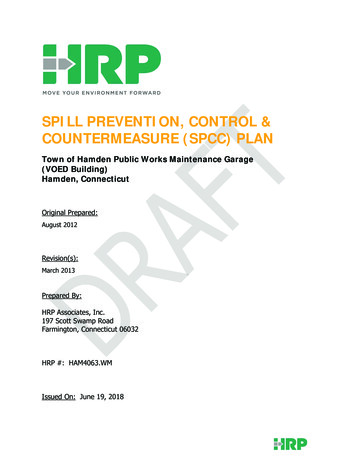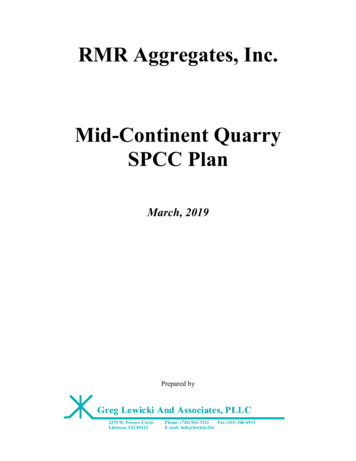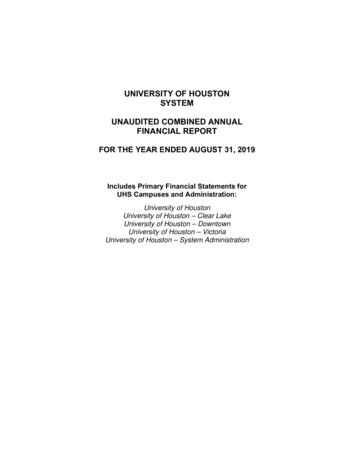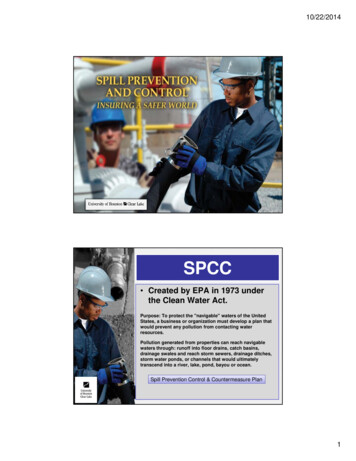
Transcription
10/22/2014SPCC Created by EPA in 1973 underthe Clean Water Act.Purpose: To protect the "navigable" waters of the UnitedStates, a business or organization must develop a plan thatwould prevent any pollution from contacting waterresources.Pollution generated from properties can reach navigablewaters through: runoff into floor drains, catch basins,drainage swales and reach storm sewers, drainage ditches,storm water ponds, or channels that would ultimatelytranscend into a river, lake, pond, bayou or ocean.Spill Prevention Control & Countermeasure Plan1
10/22/2014SPCCWhat substances fall under theSPCC rules?Petroleum product – In Texas, a petroleum product is defined as a petroleumsubstance obtained from distilling and processing crude oil that is liquid atstandard conditions of temperature and pressure, and that is capable of being usedas a fuel for the propulsion of a motor vehicle or aircraft, including but notnecessarily limited to motor gasoline, gasohol, other alcohol blended fuels,aviation gasoline, kerosene, distillate fuel oil, and #1 and #2 diesel.The term does not include naphtha-type jet fuel, kerosene-type jet fuel, or a petroleumproduct destined for use in chemical manufacturing or feedstock of that manufacturing.30TAC327.2Substances that fall underSPCC rulesIf the substance is derived from a petroleum source or can beextracted by an organic solvent, it is regulated under SPCC rules.The types of oils include mineral (petroleum), vegetable, animal,essential, and edible.Examples KeroseneDiesel FuelGasolineMotor Oils & Lubricating OilsTarsAsphaltsCrude OilsNaphthaMineral SpiritsTransformer OilHeating OilsCutting Oils Paraffin WaxAnimal & Vegetable Fats/OilWhale OilCoconut OilCorn OilTallowMeat RenderingFish OilTung OilLinseed OilCottonseed Oil2
10/22/2014Substances that fall underSPCC rulesOils stored at UHCL include: vehicle fuels, varioushydraulic, lube, motor, and used oils utilized in campusequipment, elevators, and vehicles; as well as usedcooking grease from the on-campus cafeteria. Inaddition, some campus transformers contain 55 ormore gallons of oil.Oils stored at the campus in containers having acapacity equal to or exceeding 55-gallons include:1. Oil Storage Containers: 55-Gallon DrumsDiesel Emergency Generator TanksUsed Oil TankA split tank for vehicle refueling containing both diesel and gasoline.2. Oil-Filled Equipment: Elevator Hydraulic Oil Tanks Electrical Transformers Oil-Water SeparatorsSPCC: Three PointSectionsPreventionHow can we prevent a spill fromoccurring?ControlHow do we control a spill if itoccurs?CountermeasuresHow do we clean-up and reportspills?3
10/22/2014SPCC: PreventionTrainingAwareness of Work EnvironmentInspectionsSafety DevicesRegular MaintenanceBest Work PracticesCorrosion ProtectionSpill Prevention Procedures &MethodsPrevention : TrainingOur SPCC Plan says:Personnel are instructed in the operation and maintenance ofequipment to prevent discharges of oil, discharge procedureprotocols; applicable pollution control laws, rules, andregulations; general campus operations; and, the contents ofthe campus SPCC Plan (including the use of the QRG).Training for oil-handling personnel will be performed annually.CWA §112.7(f)(1) - At a minimum, train your oilhandling personnel in the operation and maintenanceof equipment to prevent discharges; dischargeprocedure protocols; applicable pollution control laws,rules, and regulations; general facility operations;and, the contents of the facility SPCC Plan.4
10/22/2014Prevention : TrainingContinued .Our SPCC Plan Says UHCL will schedule and conduct discharge prevention briefings for oilhandling personnel at least once per year to assure that they have anadequate understanding of the campus SPCC Plan, its requirements,and their responsibilities. These briefings will highlight knowndischarges or failures, malfunctioning components, and any recentlydeveloped precautionary measures.CWA §112.7(f)(3) - Schedule and conduct discharge prevention briefings foryour oil-handling personnel at least once a year to assure adequateunderstanding of the SPCC Plan for that facility. Such briefings must highlightand describe known discharges as described in §112.1(b) or failures,malfunctioning components, and any recently developed precautionarymeasures.SPCC: PreventionBest Work PracticesAre you using the Best Available ControlTechnology (BACT) or the cheapest technology?Are you doing your work the best way or thequick and easy way?5
10/22/2014SPCC: PreventionRegular MaintenanceAre there regular scheduled maintenance checks and partreplacements?Corrosion protectionAre you preventing corrosion form occurring?Reporting if you find corrosion of oil containing equipment?Does it have corrosion protection?Safety DevicesIs there an emergency cut-off switch?Lock-out Tag-out?SPCC: PreventionAwareness of Work EnvironmentDo you know what is going on around you?Does anything look out of place?Any new or old hazards?Spill Prevention Procedures & MethodsQ: What procedures and work routines are already in placein your department to prevent spills and control hazards?A: Oil Loading and Unloading Procedures Bulk Delivery Procedures (In SPCC) Bulk Oil Collection/Pick-up (In SPCC)B. Preventative Maintenance Program (FMC)6
10/22/2014SPCC: InspectionsWhat do we need to Inspect? Transformers (Electricians only!) Above Ground Storage Tanks (Pump Station, Used Oil) Emergency Generators Drums (Shop, Central Plant, HW Storage, etc.) Hydraulic reservoir(Elevators) Oil Water Separator (not on form, but for CLWA) Kitchen Grease Disposal collection areas.Inspect areas for leaks, integrity, housekeeping,maintenance malfunctions, etc.Prevention:Prevention: InspectionInspectionsHow often do we inspect these areas?A: At Least QuarterlyQ: Where is the form located?A: Facilities Management shoulddelegate the inspector(s) and provide theinspection sheets within the SPCC plan.7
10/22/2014Prevention:InspectionsQuarterly Inspection checklist:Prevention: InspectionsContinued Quarterly Inspection checklist includes these sections: Tanks Piping Loading/Unloading/Transfer Equipment Dispensing Equipment Portable Containers Oil-Filled Equipment Emergency ResponseEquipment SecurityInspect areas for leaks,integrity, housekeeping,maintenance malfunctions,etc.Listed by Locations:Bayou BuildingArbor BuildingDelta BuildingStudent Service BuildingFMC BuildingNOA 1 BuildingSee Inspection Handout8
10/22/2014Prevention: InspectionsContinued SPCC Plan Tables:Table 1: Oil Storage Tank and Container InventoryTable 2: Oil-Filled Mechanical Equipment InventoryTable 3: Oil-Filled Electrical Equipment InventorySee SPCC Plan for Tables and MapsEmergency Response Equipment is located ineach building where a risk of spill exists.Prevention: InspectionLocationsOil-Filled Mechanical EquipmentElevator Hydraulic tanks larger than 55 gallonsRequire quarterly inspections, including a third party contractor formaintenance issues, as well as a yearly state inspection to operate.Locations: Bayou BuildingStudent ServicesDeltaTable 2 in SPCC Plan Appendices has locationsand quantities of elevator hydraulic oil.9
10/22/2014Prevention: InspectionLocationsOil-Filled Electrical EquipmentTransformersThere are 10 pad-mounted transformers that contain 55 gallonsor more of oil. Third party annual inspections, 5 year infraredand oil integrity testing, routine, plus quarterly SPCCinspections.Locations: Bayou Building (140-245 gallons)Delta (308 gallons)Arbor (240 gallons)NOA (174 gallons)Table 3 in SPCC Plan Appendices haslocations and quantities of transformers.Prevention: InspectionLocationsOil Storage Tank & Container InventoryTable 1 in SPCC Plan Appendices haslisted Quantities & Locations.Generators Diesel (250) FMCDiesel (850) SSCBThe emergency generators are tested monthly by FMCpersonnel. In addition, third party contractors conductquarterly inspections of the generators.Follow Bulk oil delivery, Collections/Pick-up procedures.10
10/22/2014Prevention: InspectionLocationsOil Storage Tank & Container InventorySee Table 1 and Inspection ListAbove Ground Storage Tanks (AST)Used oil Tank AST 400 gallon Used OilSplit Tank AST: 1000 DieselAST: 4,000 Gasoline.UHCL will inspect its bulk oil tanks in accordance with the industrystandards outlined in the Steel Tank Institute’s (STI) Standard for"Inspection of In-Service Shop Fabricated Aboveground Tanks forStorage of Combustible and Flammable Liquids" - SP001Routine visual inspections of all oil containers, piping, joints, unions,valve and pump seals and bodies, pipe supports and metal surfaces.Prevention: InspectionLocationsOil Storage Tank & Container InventoryTable 1 in SPCC has listed Quantities & Locations.Drums (various quantities) FMC, Bayou, Hazardous Waste Storage DOT Approved Container Drums must be replaced every7yrs for Poly & 12yrs for Steel. Closed at all times Secondary containment is requiredfor all 55 gallon containers. If exposed to the outside, they mustbe able to hold the drum contentsand the rain!11
10/22/2014SPCC: Control MethodsEngineering Controls Secondary Containment: Dikes,berms, retaining walls, spill pallets Rain Covers Curbs Drainage systems Ponds Alarms Double walls Absorbent materials Drain Covers Pump Start controls (for refueling)SPCC: Control Methods Keep containment areas clean and wellmaintained. Report damages of any engineered controldevices or collection areas. Report water or other substances located incontainment areas, clean and dispose ofmaterial. Keep drain valves locked in the closedposition. Utilize log books and inspections forms. Inspect for oil prior to pumping water out.12
10/22/2014Inspection: SummaryIf the inspection reveals an issue with theintegrity of the tank, container, or containmentthat could result in: a release of oil, including, butnot limited to leaking seams, gaskets, flanges,piping, pumps, valves, rivets, and bolts, theinspector will take immediate action to correct thedeficiency, and record on the Corrective ActionForm found in the SPCC Plan.SPCC: CountermeasuresIn House clean-up Facilities Personnel EH&S StaffContractor Clean-up SWS Environmental Services Garner Environmental Services Allied International Emergency13
10/22/2014SPCC: CountermeasuresLocal Clean-upSmall Spills: Facilities personnelEmployees handling oil/gasoline (As defined by EPA)should clean-up small incidental spills.Examples Filling gas can and pouring over Slow transformer leak Emergency Generator Leak Car leak in Shop Leakage from lawn equipment (lawn mower, hedger, chainsaw, etc.) Kitchen grease spillSPCC: CountermeasuresPicture examples of smallleaks/spills for employee clean-up.Emergency Generator Leak Fill out inspectionSheet. Cleanup areausing oilabsorbentmaterial. Report tomanagement. Fill out correctiveaction report.14
10/22/2014SPCC: CountermeasuresPicture Examples of smallleaks/spills for employee clean-up.Transformer Leak Electrician fills outinspection sheet. Cleanup areausing oilabsorbentmaterial. Report tomanagement. Fill out correctiveaction report.SPCC: CountermeasuresLocal clean-upEH&S Staff in Risk ManagementCleans up spills that reach beyond incidental, that could potentiallybecome reportable levels or hazardous.Test atmosphere for the LEL ( Lower and Upper Explosive Limits ) andToxicity Levels.Transformer oilsContact EH&S for assistance and to contact authorities as needed.24 gallons of fuel or used oil is reportable on land.If any oil is found in the waterway it is reportable.Gasoline and DieselIf gasoline or diesel is spilled inside beyond incidental, please contactus to measure vapors for health concerns.If spilled outside, contact us for assistance if greater than 2 gallons(24 gallons is reportable) and we will assist.15
10/22/2014SPCC: CountermeasuresMost people can begin to smell gasoline at 0.25 parts of gasoline permillion parts of air (ppm).The Occupational Safety and Health Administration (OSHA) regulateslevels of gasoline and diesel in the workplace. The maximum amount ofgasoline allowed in workroom air during an 8-hour workday of a 40hour workweek is 900 milligrams of gasoline vapor per cubic meter ofair (mg/m3), or 300 ppm Gasoline and Diesel TLV is 15 ppm.Certain workers have a greater risk of exposure to gasoline type vapors. Theseinclude service station attendants, drivers of gasoline tank trucks, workers at bulkloading terminals and marine loading docks, workers who remove and serviceunderground storage tanks and gasoline pipelines, workers who find and clean upgasoline spills and leaks, and refinery workers. If you have any of these jobs, youare probably exposed to small amounts of gasoline vapors every day you work. Ifyou work at a job using gasoline-powered equipment or vehicles, you may beexposed to gasoline and its vapors.SPCC: CountermeasuresLocal clean-upEH&S Staff in Risk ManagementExamples: Gasoline station is being refilled by a tanker truck. Thetruck over flows. Transformer leaked 150 gallons overnight. Used Oil Drum spills on the ground. The amount is lessthan reportable, but has strong fumes. Gasoline Drum spills outside. Emergency generator leaks 10 gallons of diesel on theground. Contacting spill response team, local authorities,reporting to EPA and TCEQ.16
10/22/2014SPCC: CountermeasuresLarge Spills forEmergency Clean-up:Re-Fueling Leak Ensure Bulk deliveryprocedures are beingfollowed by contractors. Stop flow if safe to do so. Inform your Manager,Risk Management andPolice. Block flow from reachingdrains and waterways, ifsafe to do so. EH&S and/or EmergencyPersonnel can clean-up.SPCC: Emergency ProceduresPlease seehand-out atthis time17
10/22/2014SPCC: QRGQuick Reference Guide: QRGAvailable at all Spill Supply locations and where largevolumes of oil are stored. If safe and easy to do so, stop the leak.Inform Risk Management, FMC and Police.Risk Management with FMC will determine the size of spilland if contractors need to be called for clean-up.Risk Management will contact State and Federal agencies. The QRG contains: Emergency Diagram Spill Notifications Contact InformationKnow your role in the EmergencyResponse PlanSPCC: Countermeasures Spill response material are located in each building containing oilequipment. PPE is located within the drum - Intended to control spread ofspills or can be used to clean-up small spills. Small spills can be handled with small kits within your area. Picture and examples of drum, clean up materials (kitty litter,pads, absorbent booms, etc.). Contact EH&S for disposal. Questions about any spills Reporting18
10/22/2014What Departments Implementthe Emergency Plan?FMCPoliceCoordinateRiskManagementSPCCAny Questions?19
SPCC: Prevention Our SPCC Plan says: Personnel are instructed in the operation and maintenance of equipment to prevent discharges of oil, discharge procedure protocols; applicable pollution control laws, rules, and regulations; general campus operations; and, the contents of the campus SPCC Plan (including the use of the QRG).
